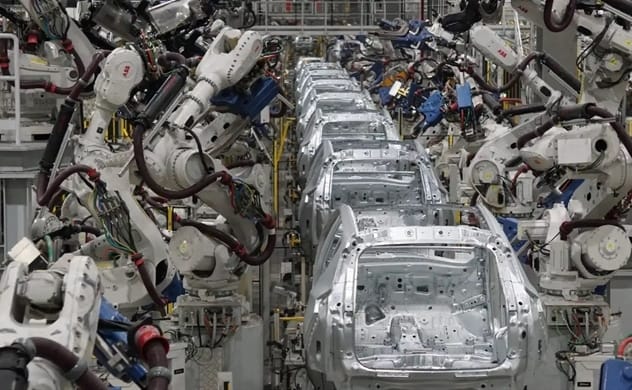
VinFast’s plant in Vietnam’s Haiphong is 90% automated, according to the company’s CEO. Photo by Yuji Nitta.
Vietnamese conglomerate Vingroup has made a big bet on the global shift to electric vehicles. But its EV business has struggled to take off, bogged down by a domestic market slow to embrace electrification and a troubled rollout in the U.S. market.
This is a “world-class manufacturing facility where 90% of processes are automated,” said VinFast CEO Le Thi Thu Thuy during a recent visit to the site.
“VinFast’s strength lies in its speed,” Thuy said. “We can do things that existing manufacturers with complex [decision-making] systems cannot do.”
In 2019, VinFast became the first Vietnamese company to manufacture a homegrown gasoline-powered vehicle. It made the jump to EVs in 2021 in a bid to ride the global electrification push, before abandoning gas vehicles altogether in 2022.
The interior design for VinFast’s vehicles mimics EV giant Tesla’s in eschewing physical gauges and switches in favor of a large display in the center of the dashboard. All of the company’s four EV models, including a sport utility vehicle, are produced at the Haiphong plant, whose staff includes foreign technicians and engineers from about 30 countries.
A press machine expert from Brazil with nearly 30 years of experience at Hyundai Motor and other automakers said he joined the company to take on a new challenge. The Turkish supervisor of the assembly process came from European automaker Stellantis. Other workers have come to the plant from Toyota Motor, General Motors and Tesla.
But facility utilization remains low at the vaunted Haiphong factory amid tepid domestic demand. Vietnam’s four-wheeled vehicle market is small, with an annual scale of 400,000 to 500,000 units, as cheap two-wheelers are preferred in the country. EVs, including those from rivals like Tesla, are a relatively rare sight on the streets.
VinFast sold just 7,400 vehicles in 2022. Assuming the Haiphong facility’s production capacity of 38 units per hour, or a maximum of 250,000 units per year, the factory utilization rate for EVs last year stood at around 3%.
In addition to installing charging facilities in urban areas such as Hanoi, Vingroup is producing car batteries jointly with China’s Contemporary Amperex Technology (CATL) and has also begun recycling batteries. It has entered the EV taxi market and partnered with a ride-hailing app startup.
To encourage consumers who are skeptical about EVs, the company has even started a service to buy back its used EVs after five years.
“Companies in Vingroup complement each other, and our expertise can generate synergies,” said Thuy.
While trying to nurture the domestic market, VinFast is also intent on grabbing a piece of the huge U.S. market, but a rushed vehicle rollout has led to a bumpy ride.
After a delayed start, the company was forced to recall all 999 units it had shipped to the U.S. in the first batch. The software defect that triggered the recall was a concern even before export. The production launch at the company’s U.S. plant, which is expected to have an annual production capacity of 150,000 units, has also been pushed back from July 2024 to 2025 or later.
Due to heavy upfront investment, the company’s manufacturing business — including EVs — was 14 trillion dong (around $590 million) in the red for the first half of 2023, a slight year-on-year improvement from 16 trillion dong in losses.
“By 2024, sales will reach 60,000 to 70,000 units, and EBITA [earnings before interest, taxes and amortization] will break-even,” Vingroup founder Pham Nhat Vuong said in May. “We will be able to generate profits in fiscal 2025.” But the outlook is murky.
Vuong is known as Vietnam’s real estate king. An instant noodle business he started in Ukraine in 1993 was his first step as an entrepreneur. In the 2000s, he invested the money he earned from that venture into a commercial facility and a resort in his home country. Riding the wave of rapid economic growth, he became one of the richest men in Vietnam.
He is a sharp-eyed risk-taker and quickly abandons businesses once he sees them as failing. The company has dabbled in smartphones and TVs in the past, but Vuong decided to withdraw after just two or three years. He sought to create a domestic home appliance brand but was unable to compete with the leading Chinese and South Korean players.
That’s why his decision this spring to bolster VinFast with $1 billion from his own personal assets can be seen as a sign of his deep commitment to the EV business.
Still, Vuong cannot afford to just wait for VinFast to get off the ground. Despite billions of dollars in investments already, upfront costs are set to increase further due to construction of the U.S. plant as well as research and development costs.
Sales for the entire group have been on the rise in the last 10 years, but profits have not caught up, with the group falling into a net loss in 2021. As its total assets expanded rapidly after 2019, when it started producing gasoline vehicles, its asset efficiency deteriorated. Vingroup’s stock price is less than half of the peak it hit before EV production began.
The group’s long-awaited U.S. listing has also been rocky. It rushed to file an application for listing at the end of 2022, but the road to an initial public offering proved difficult. In May, it switched to a listing through a merger with a special acquisition company, which will hold a shareholders meeting on Aug. 10 to approve the merger.
Source: Nikkei Asia





